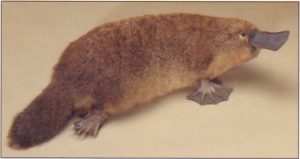THE CREATION IS ENGINEERED – NOT EVOLVED!
The playtpus, commonly called “the duck-billed platypus” (Ornithorhynchus anatimus), is indeed one of God’s most unique and highly engineered animals. This is one of the animals where evolutionists have no common ancestor assigned, which is saying quite a lot considering all of the common ancestors they have conjured up for other animals.
It is easy to see why they are having such difficulty with an evolutionary path for the platypus when its mixture of features are considered:
- It has a bill like a duck even with nostrils on top of its bill.
- It lays leathery eggs to reproduce itself like reptiles.
- Also like reptiles, it has claws and a similar shoulder girdle.
- It has a single ventral opening for waste elimination, mating and birth.
- Its bill can detect electrical currents like some fish.
- It has webbed feet like a beaver.
- The male has a hollow horny spur on its rear ankles that is connected to a venom gland in its thigh. The venom causes extreme pain in humans. This poisonous ability is like that of many snakes.
- The females have mammary glands, thus its assignment as a mammal.
When the first platypus specimens were sent to Britain from Australia in the late 1700s, the scientists who studied them thought a clever taxidermist had stitched together parts from several different animals. Clearly though, the platypus is engineered for its environment and is not on the way toward evolving into any other animal. It is a sleek 3-4 pound swimmer that feeds on bottom-dwelling invertebrates in the streams, rivers and lakes of eastern Australia.
Less than two feet long (the platypus has a dark brown coat, silver to light brown underneath), these animals show great parenting skills with their young. At one time they were threatened with extinction, but conservation efforts have for now eliminated that threat.
As I stated in the first paragraph, the platypus has no evolutionary ancestor. In reality this is true in general for all mammals as well. In fact, all species appear, as fossils and as living, fully developed, not partly developed. “There are no examples of half-developed feathers, eyes, skin, tubes (arteries, veins, intestines, etc.) or any of the vital organs (dozens in humans alone.)”*
Partially developed organs are a liability and would only lead to quick extinction. For example, an arm of a dinosaur would become a useless liability before it would ever become a useful wing. In fact, completely different types of lifeforms are only seen going extinct and never seen coming into existence.
J.D. Mitchell
*Brown, Walt, In the Beginning, 8th Edition, page 7.



